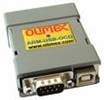Nokia 3410 LCD on the STM32
 The Nokia LCD displays are among my favourite toys. Generally, I use a monochrome display intended for the Nokia 3410 ‘phone. This a display size of 96 x 48 pixels and can display bitmaps as well as text in 6 rows of 16 characters. It is smaller than the more common 16×2 text-only displays, easier to drive, cheaper, uses fewer connections, much more flexible and is readily available. And now, I have connected one up to my STM32F103 Cortex-M3 processor. As a first go with the SPI peripheral on these processors, it has been quite instructive…
The Nokia LCD displays are among my favourite toys. Generally, I use a monochrome display intended for the Nokia 3410 ‘phone. This a display size of 96 x 48 pixels and can display bitmaps as well as text in 6 rows of 16 characters. It is smaller than the more common 16×2 text-only displays, easier to drive, cheaper, uses fewer connections, much more flexible and is readily available. And now, I have connected one up to my STM32F103 Cortex-M3 processor. As a first go with the SPI peripheral on these processors, it has been quite instructive…
 While I have a couple of STM32 development boards already, I was looking around for something a bit more flexible. Somehow, development kits always seem to have the wrong set of peripherals and pins I want to play with are not available. After a bit of hunting, I came across this board, made by ETT. It comes in a convenient, small size with two single rows of pins for the IO. Perfect for plugging into a breadboards for some proper playing…
While I have a couple of STM32 development boards already, I was looking around for something a bit more flexible. Somehow, development kits always seem to have the wrong set of peripherals and pins I want to play with are not available. After a bit of hunting, I came across this board, made by ETT. It comes in a convenient, small size with two single rows of pins for the IO. Perfect for plugging into a breadboards for some proper playing…

